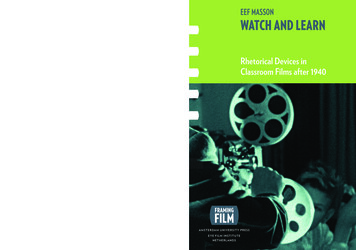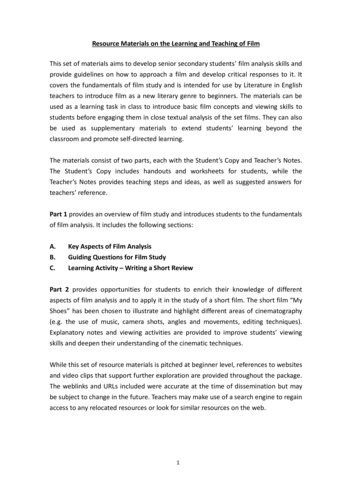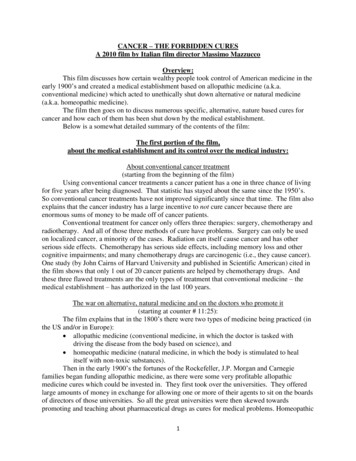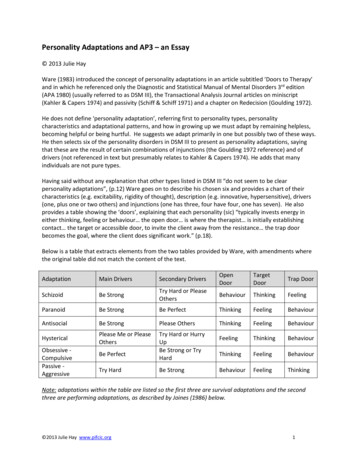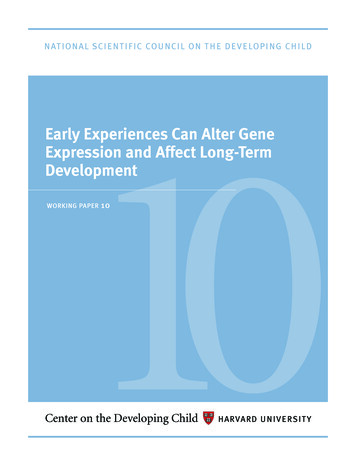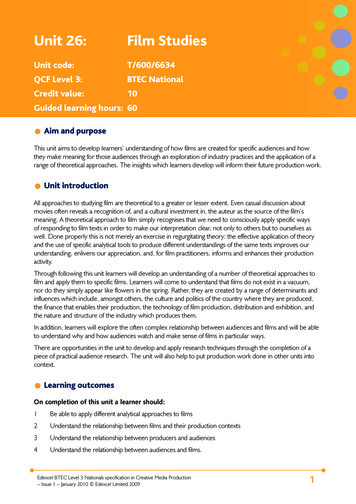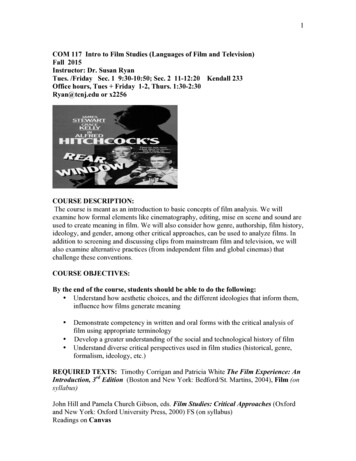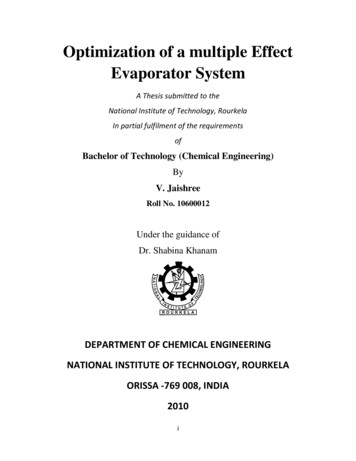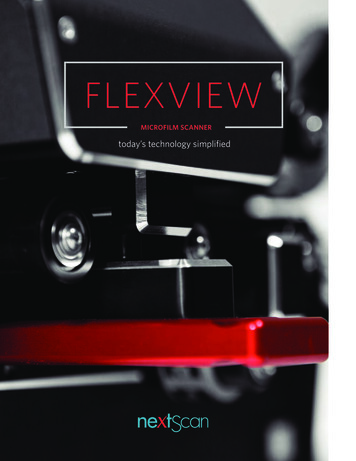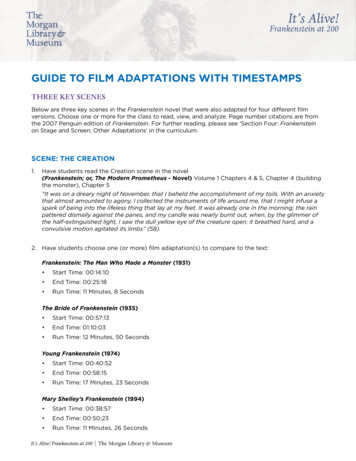
Transcription
It’s Alive!Frankenstein at 200GUIDE TO FILM ADAPTATIONS WITH TIMESTAMPSTHREE KEY SCENESBelow are three key scenes in the Frankenstein novel that were also adapted for four different filmversions. Choose one or more for the class to read, view, and analyze. Page number citations are fromthe 2007 Penguin edition of Frankenstein. For further reading, please see ‘Section Four: Frankensteinon Stage and Screen; Other Adaptations’ in the curriculum.SCENE: THE CREATION1.Have students read the Creation scene in the novel(Frankenstein; or, The Modern Prometheus - Novel) Volume 1 Chapters 4 & 5, Chapter 4 (buildingthe monster), Chapter 5“It was on a dreary night of November, that I beheld the accomplishment of my toils. With an anxietythat almost amounted to agony, I collected the instruments of life around me, that I might infuse aspark of being into the lifeless thing that lay at my feet. It was already one in the morning; the rainpattered dismally against the panes, and my candle was nearly burnt out, when, by the glimmer ofthe half-extinguished light, I saw the dull yellow eye of the creature open; it breathed hard, and aconvulsive motion agitated its limbs” (58).2. Have students choose one (or more) film adaptation(s) to compare to the text:Frankenstein: The Man Who Made a Monster (1931) Start Time: 00:14:10 End Time: 00:25:18 Run Time: 11 Minutes, 8 SecondsThe Bride of Frankenstein (1935) Start Time: 00:57:13 End Time: 01:10:03 Run Time: 12 Minutes, 50 SecondsYoung Frankenstein (1974) Start Time: 00:40:52 End Time: 00:58:15 Run Time: 17 Minutes, 23 SecondsMary Shelley’s Frankenstein (1994) Start Time: 00:38:57 End Time: 00:50:23 Run Time: 11 Minutes, 26 SecondsIt’s Alive! Frankenstein at 200 The Morgan Library & Museum
It’s Alive!Frankenstein at 200SCENE: THE CREATURE AND CHILD1.Have students read the scene involving the monster and the child in the novel(Frankenstein; or, The Modern Prometheus - Novel) Volume 2, Chapter 8 (or Chapter 16 if thecopy doesn’t have volumes listed)“I was scarcely hid, when a young girl came running towards the spot where I was concealed,laughing, as if she ran from some one in sport. She continued her course along the precipitous sidesof the river, when suddenly her foot slipt, and she fell into the rapid stream. I rushed from my hidingplace, and with extreme labour from the force of the current, saved her, and dragged her to shore.She was senseless; and I endeavoured, by every means in my power, to restore animation, when Iwas suddenly interrupted by the approach of a rustic, who was probably the person from whom shehad playfully fled. On seeing me, he darted towards me, and tearing the girl from my arms, hastenedtowards the deeper parts of the wood. I followed speedily, I hardly knew why; but when the mansaw me draw near, he aimed a gun, which he carried, at my body, and fired” (142-143).2. Have students choose one (or more) iconic film adaptation(s) to compare to the text:Frankenstein: The Man Who Made a Monster (1931) Start Time: 00:47:42 End Time: 00:50:23 Run Time: 2 Minutes, 53 SecondsYoung Frankenstein (1974) Start Time: 01:04:52 End Time: 01:06:32 Run Time: 1 Minute, 40 SecondsMary Shelley’s Frankenstein (1994) Start Time: 01:14:44 End Time: 01:18:08 Run Time: 3 Minutes, 24 SecondsIt’s Alive! Frankenstein at 200 The Morgan Library & Museum
It’s Alive!Frankenstein at 200SCENE: THE WOMAN ON THE BED1.Have students read of Elizabeth’s fate.(Frankenstein; or, The Modern Prometheus - Novel) Volume 3, Chapter 6 (or Chapter 23 if thecopy doesn’t have volumes listed)“She was there, lifeless and inanimate, thrown across the bed, her head hanging down, and herpale and distorted features half covered by her hair. Every where I turn I see the same figure - herbloodless arms and relaxed form flung by the murderer on its bridal bier” (199).2. Have students choose one (or more) iconic film adaptation(s) to compare to the text:Frankenstein: The Man Who Made a Monster (1931) Start Time: 00:54:12 End Time: 00:55:30 Run Time: 1 Minute, 18 SecondsYoung Frankenstein (1974) Start Time: 01:32:42 End Time: 01:35:23 Run Time: 2 Minutes, 41 SecondsMary Shelley’s Frankenstein (1994) Start Time: 01:39:42 End Time: 01:41:12 Run Time: 1 Minute, 30 SecondsHave students compare and contrast their chosen scenes with the novel. What issimilar? What is different? How does viewing a scene affect the audience differentlythan reading a scene? Does the artistic license of the director impact how you interpretthe scene and its characters? Please compare and contrast, explaining your ideas.It’s Alive! Frankenstein at 200 The Morgan Library & Museum
It’s Alive!Frankenstein at 200RELATED FILMSNOTE FOR TEACHERS:This supplement expands on curriculum Section Four: Frankenstein on Stage and Screen; OtherAdaptations. It contains an alternate discussion focus for the James Whale film and additionalfilm suggestions related to Frankenstein with discussion points and activities.1. Frankenstein: The Man Who Made a Monster (James Whale/1931/71 minutes)While the Creature is never precisely described in Mary Shelley’s novel, it can be argued that BorisKarloff’s portrayal of the Creature continues to be the dominant visual image to this day. This can beattributed to various creative decisions on Karloff’s part as an actor, but is also in large part due tothe makeup. Jack P. Pierce, who went on to provide makeup for other horror films such as Dracula,The Bride of Frankenstein, The Wolf Man, and Phantom of the Opera, worked for weeks with Karloff tocombine Pierce and Whale’s ideas and create the look of the movie’s monster. However, contemporaryviewers may struggle to find the 1931 film as scary today as it was to its original audiences. It istheorized that “ horror like humor is a cultural construct redefined by each new generation.”1DISCUSSION PROMPTS:Once the students have read the novel, have them reflect on whether they find the storyfrightening. Do the ideas presented in in the book feel outdated or too familiar?Have the students screen Frankenstein: The Man Who Made a Monster. Ask students to discusscinematic elements that may have been terrifying to a 1931 audience. Are these techniques stillused today in film? What do you think defines a horror/scary movie? Do any modern films remindthem of Whale’s film?Ask students to reimagine a scene from the 1931 film. Develop a performance style for theCreature or the bride from the 1935 sequel. Include elements such as costume design or effectsmakeup. For example, will their version speak? How will he/she move? How will they depict theotherness of the Creature?1 Single, Lori Leathers. “Reading Against the Grain: The U.S. Reception of Branagh’s “Mary Shelley’s Frankenstein.” Studies in Popular Culture,Vol. 21, No. 2 (October 1998), p.5.It’s Alive! Frankenstein at 200 The Morgan Library & Museum
It’s Alive!Frankenstein at 2002. Mary Shelley’s Frankenstein (Kenneth Branagh/1994/123 minutes)In the 1994 film Mary Shelley’s Frankenstein, director and star Kenneth Branagh attempted to adapt thenovel more faithfully than the 1931 Whale film. Despite innovative makeup, modern special effects, andthe inclusion of novel elements such as the Robert Walton storyline, the film is generally considered tobe a flop.2 It is criticized for lacking the iconic power of either the original novel or the Whale film.DISCUSSION PROMPTS:Ask the students to discuss the idea of adaptation. What are some of their favorite literaryadaptations (to film)? Why are they successful? How do the films differ from the books?Ask students to debate the idea of the “book is always better than the movie.” Are thereexceptions to this? What are examples?Compare The Bride of Frankenstein and Mary Shelley’s Frankenstein and their attempts to addMary Shelley as a character to her own novel. In Bride, Elsa Lanchester plays a double role asMary Shelley/The Bride. In the Branagh film, the character of Elizabeth is updated to resembleBranagh’s version of Mary Shelley’s personality. After Elizabeth is murdered, she is reanimatedas a second Creature (using other body parts from the character of Justine) and is ultimately sodistraught to find out what’s been done to her that she commits suicide. Ask students to discusshow they might add Mary Shelley to an adaptation of the novel.2 Single, Lori Leathers. “Reading Against the Grain: The U.S. Reception of Branagh’s “Mary Shelley’s Frankenstein.” Studies in Popular Culture,Vol. 21, No. 2 (October 1998), p.1.It’s Alive! Frankenstein at 200 The Morgan Library & Museum
It’s Alive!Frankenstein at 2003. The Iron Giant (Brad Bird/1999/86-90 minutes)The film The Iron Giant “tells the tale of an artificial being that, in precise contrast to Frankenstein’smonster, receives the proper nurturing and moral education from a warm-hearted surrogate parent ”3This animated film tells the story of an interstellar robot who crashes on Earth with no memories orprogramming and is adopted by a human boy, Hogarth. Like the Creature of Shelley’s novel, the robot isa blank slate. The Iron Giant “ matches Shelley’s novel almost point for point in terms of the monster’seducation and emotional development, with each deviation remaining explicitly within the bounds ofhow, in [director] Bird’s understanding, Shelley’s monster might have ended up.”4 This contemporaryreimagining features an absent creator, but unlike Mary Shelley’s novel, imagines a scenario wherecharacters reminiscent of the de Lacey family actually accept the Creature. The character of the IronGiant is a destructive machine built for war. But, due to his education from Hogarth, the giant is able tooverride his programming and protect his new human family.DISCUSSION PROMPTS:Before viewing The Iron Giant, ask the students to reflect on the Creature’s lack of parenting anddiscuss how this influenced the development of his character.Ask students to consider nature vs. nurture. Do they think the Creature’s true nature was violent?Or is it a product of his lack of nurturing by Victor Frankenstein?Now view The Iron Giant and ask students to draw parallels between the two “monster”characters.If students have also viewed other film adaptations, such as James Whale’s, ask them if they seeany similarities between The Iron Giant and other Frankenstein film adaptations. Where are theysimilar? Where do they deviate? Is the Iron Giant more similar to one adaptation over another?3 Miller, T.S. “Frankenstein without Frankenstein: ‘The Iron Giant’ and the Absent Creator.” Journal of the Fantastic in the Arts, vol. 20, no. 3,2009, p. 385-405.4 Ibid, p. 386.It’s Alive! Frankenstein at 200 The Morgan Library & Museum
It’s Alive!Frankenstein at 2004. Reimaginings: Frankenweenie and Edward Scissorhands (Tim Burton/1984/29 minutes) (TimBurton/2012/87 minutes) (Tim Burton/1990/105 minutes)Director Tim Burton has paid tribute, or homage, to the Frankenstein story in his films, often includingstrong visual references to the work of James Whale. The most direct example of this is his 1984 liveaction short Frankenweenie. Set in suburbia, this film reimagines the Frankenstein story by making theCreature the reanimated dog of a young boy. The short was one of Burton’s first projects while workingas an animator for Walt Disney Pictures. Clearly a project that stuck with Burton, he was able to expandthe short in 2012 into an animated feature-length film for none other than Walt Disney Pictures.Burton regularly includes elements of his suburban upbringing in his films. Oftentimes, these visualrepresentations of Burton’s suburbia are parodies of Burbank, California, where Burton was raised. Aprime example of this is the 1990 film Edward Scissorhands. While Burton himself likens this film toa fairy tale, and scholarship around the film highlights particular elements of Beauty and the Beast,there are similarities and visual representations that bear strong resemblance to Frankenstein as well.5Edward is a man-made being left only partially complete after his creator dies unexpectedly. Edward’sotherness is represented by his hands, which are scissor blades.6 This film depicts a scenario whereEdward is initially kindly cared for by his creator. Upon his creator’s death and absence, he is thentaken in by a sympathetic family and continues his discovery of the outside world. However, Edward’sjourney is ultimately circular; although embraced by some members of the community, he is ostracizedby others and eventually targeted, prompting the town’s residents and “ the housewives in EdwardScissorhands [to] turn into the villagers in Frankenstein ”7DISCUSSION PROMPTS:Ask students how they feel about the Creature being a dog in Frankenweenie. How does a dog’sinability to talk reflect other adaptations of the Creature?Can they provide examples of characters in different films that are labeled “monster” or evil butwho they also find sympathetic?Discuss the idea of “parody,” an imitation of a style with deliberate exaggeration for comic effect.How does the 1984 short Frankenweenie parody imagery and scenes from the 1931 Frankenstein?Can you think of other literary adaptations or horror films that also have parodies? What are thosefilms? What cinematic elements are similar among these parody examples?While Johnny Depp still has visible scars, his character in Edward Scissorhands is more attractivethan most adaptations of Frankenstein. How does this affect the plot in both stories? If thecreature in the novel had been “beautiful,” would his life have been different?Parody: a literary or musical workin which the style of an author orwork is closely imitated for comiceffect or in ridicule5 Ray, Brian. “Tim Burton and the Idea of Fairy Tales,” Fairy Tale Films, 200-201.6 Smith, Gavin. “Punching Holes in Reality: Tim Burton interviewed by Gavin Smith.” Film Comment, vol. 30, no. 6, November-December 1994, p. 57.7 Gavin. p. 63.It’s Alive! Frankenstein at 200 The Morgan Library & Museum
the makeup. Jack P. Pierce, who went on to provide makeup for other horror films such as Dracula, The Bride of Frankenstein, The Wolf Man, and Phantom of the Opera, worked for weeks with Karloff to combine Pierce and Whale’s ideas and create the look of th
